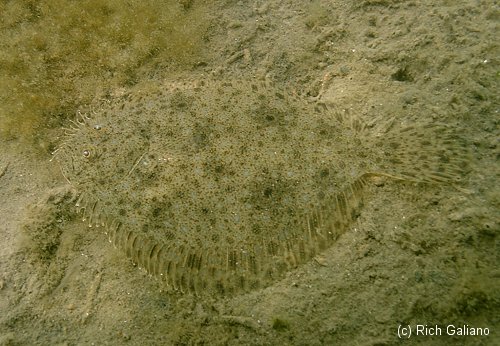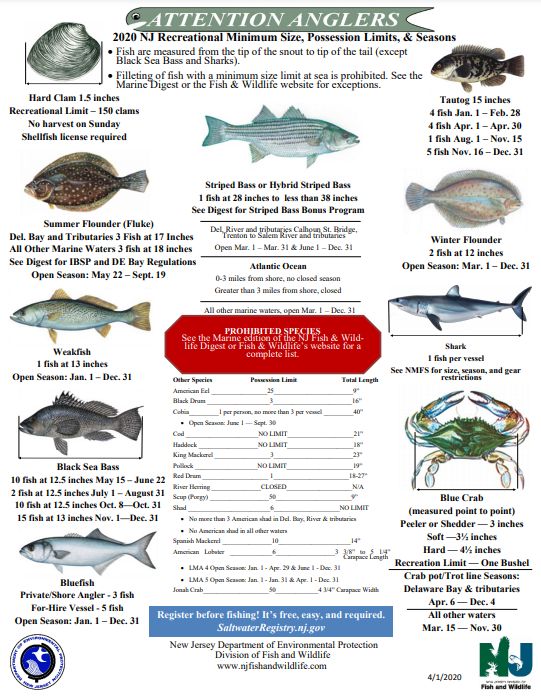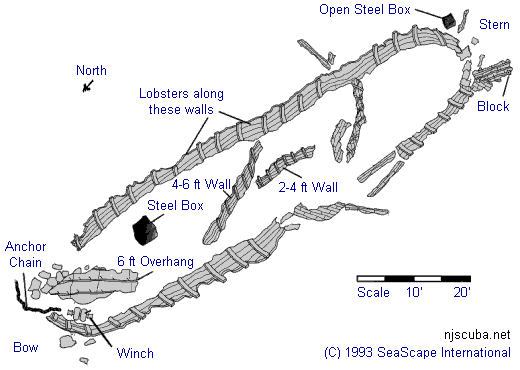Winter Flounder
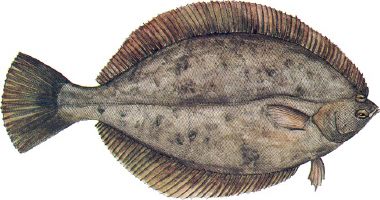
Pseudopleuronectes americanus
to 25" and 8 lbs.
usually much smaller
Profile by
Paul G. Scarlett,
Principal Fisheries Biologist
Bureau of Marine Fisheries
Common Name:
Winter Flounder,
also called Flounder, Blackback, Black
Flounder, Georges Bank Flounder, Lemon
Sole, Sole, Flatfish, Rough Flounder, and Mud Dab
Range:
Winter flounder live in estuarine and coastal waters from Labrador to Georgia. They are most common between Nova Scotia and New Jersey. Locally, winter flounder are most abundant in New Jersey's northern and central estuarine and near-shore coastal areas with numbers diminishing south of Barnegat Bay. Good populations of winter flounder can be found in Raritan Bay, Sandy Hook Bay, Navesink River, Shark River, Manasquan River, and parts of the Barnegat Bay estuarine system.
Size:
Winter flounder can grow to sizes of more than 25 inches and weigh more than 8 pounds. The New Jersey sport fish state record was landed in 1992 and weighed 5 pounds, 11 ounces. Females grow faster than males and juvenile winter flounder can reach a length of about 6 inches during their first year. Twelve-inch winter flounder are generally 3 years old and may weigh slightly more than a pound. In New Jersey, few winter flounder live past the age of 10.
Predators, Food and Feeding:
Natural predators of winter flounder include sharks, oyster toadfish, summer flounder, striped bass, monkfish, and spiny dogfish. When feeding, a winter flounder will lie motionless, partly concealed on the bottom, with its head raised off the bottom, braced by the dorsal fin. When prey is sighted, the fish remains motionless, pointing toward the prey, then lunges forward and downward to capture it. This semi-hidden feeding behavior enables the fish to effectively capture prey while at the same time providing a hiding mechanism to protect the winter flounder from its predators. Winter flounder are sight feeders and feed during daylight. Throughout their range, winter flounder eat polychaete worms, amphipod and isopod crustaceans, clam siphon tips, and plant material. They are omnivorous and opportunistic, eating whatever is available.
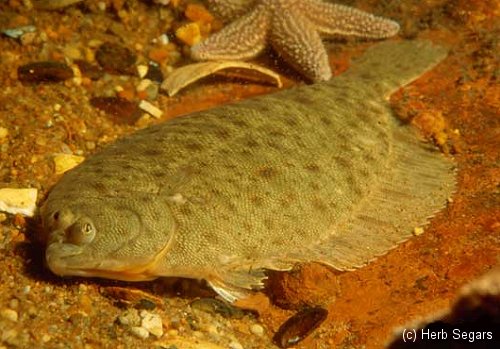
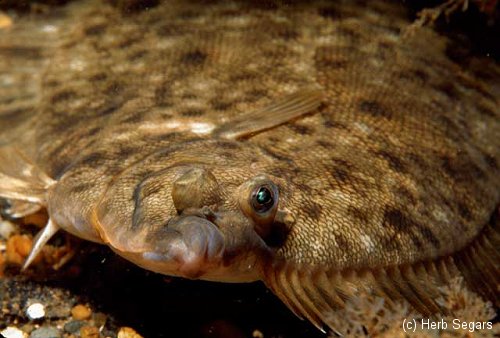
This is a right-eyed flounder. The usually dark and even coloration, tiny left-pointing mouth, and close-set eyes are identifying characteristics. Compare this headshot with the Summer Flounder.
Migration:
In New Jersey, adult winter flounder usually inhabit near-shore coastal and estuarine waters from October through May. During the summer, they migrate just off the beach to several miles offshore. In the fall, most winter flounder return to the same estuary they inhabited the previous winter. Juveniles spend their first year in estuaries where they were spawned, after which they join the adult migration.
Habitat:
Estuaries and near-shore oceanic water habitats are critically important to the life cycle of winter flounder. These areas are used as wintering, summering and spawning grounds by adults and as nursery areas by juveniles. Winter flounder prefer sand or mud-sand mixture bottoms, but can be found in creeks and seagrass beds with muddy or silty substrates.
Spawning:
In New Jersey, winter flounder spawn in estuaries from February to April at temperatures of 1°C to 10°C and salinities ranging from 10 to 35 parts per thousand. Almost all winter flounder are sexually mature by 3 years of age. Females can release as many as three million eggs, with egg numbers directly related to fish size. When hatched, winter flounder larvae are about one-tenth of an inch long. Larvae are structurally similar to those of other fish species, with one eye on each side of the head. By the time the larvae reach a size of about one-half inch, the left eye has migrated to the right side of the body and the fish assume a true flatfish, bottom-associated existence.
Importance:
Winter flounder are a highly prized food fish sought by both commercial and recreational anglers. The majority of landings from commercial fisheries are taken by otter trawl in the spring and fall. Commercial fishermen usually land between 200,000 and 300,000 pounds of winter flounder in New Jersey per year. These fish are also a mainstay of the inshore spring and fall sport fishery along the Atlantic coast. During the last 10 years, New Jersey's sport fishermen have harvested over 550,000 winter flounder per year. In terms of numbers, New Jersey annually ranks at or near the top of per state winter flounder harvest among all East coast states.
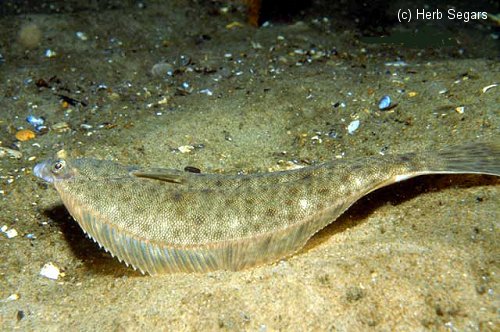
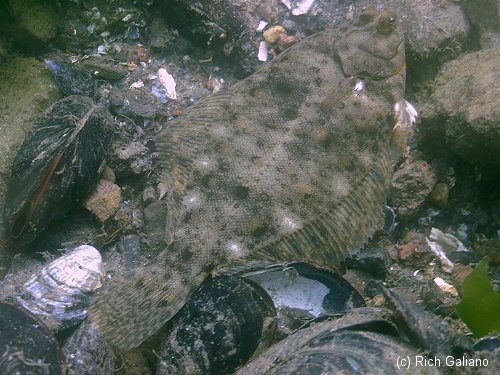
Fishing Techniques:
Winter flounder sport fishing occurs mainly within estuarine bays and rivers, usually from an anchored boat or the bank. A common fishing outfit would include a six-foot light to medium action rod and a conventional or spinning reel filled with 6 to 10 pound test. Most freshwater fishing outfits also work well for winter flounder. Winter flounder can be taken on small (#10) long-shanked hooks baited with clams, mussels or bloodworms. Whole kernel canned corn works well as bait and can also be used as chum, along with rice and crushed mussels. Stirring up the bottom under an anchored boat with heavy weights, an oar, or even a plunger fastened to a long pole will attract fish. Hooks can be fished singly, in a multiple hook rig, or with spreaders, with sinkers heavy enough to hold bottom. Winter flounder can provide lively action, especially on light tackle. Recreational harvest in New Jersey is controlled by a season and size limit.
References:
Bigelow and Schroeder (1953), Bowman, et al. (1976), Geiser (1977), NMFS (1999), Olla, et al. (1969), Pearcy (1962), Perlmutter (1947), Phelan (1992), Scarlett (1988, 1991, 1997), Scarlett and Allen (1992)
This article first appeared in New Jersey Fish & Wildlife Digest - 2000 Marine edition
There is a long closed season for Winter Flounder, so if you plan to do any spearfishing, learn the differences between this and other species, especially Summer Flounder.


